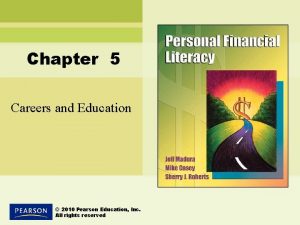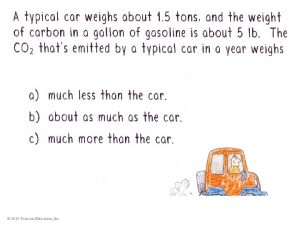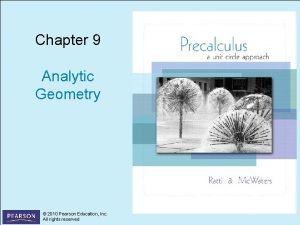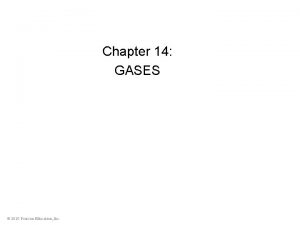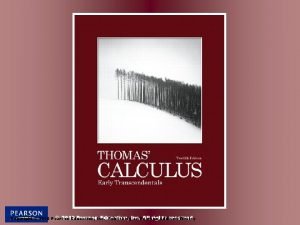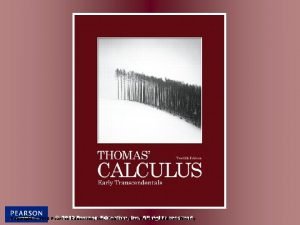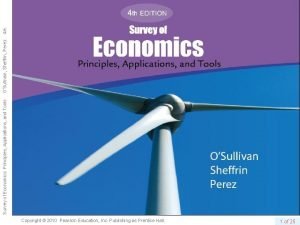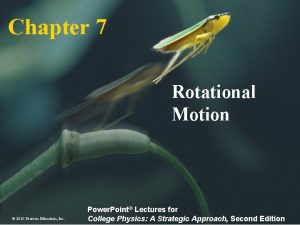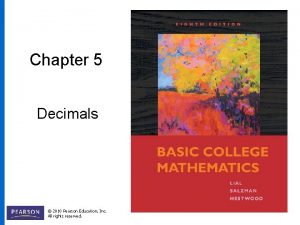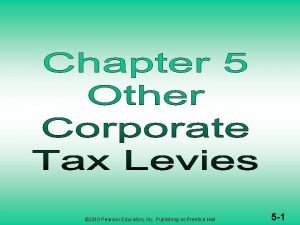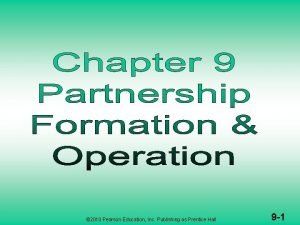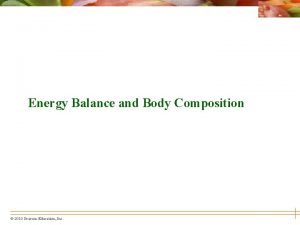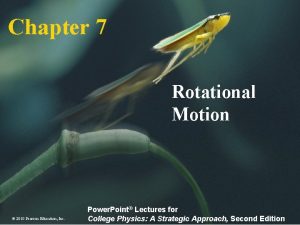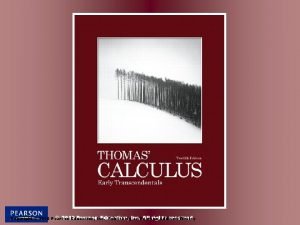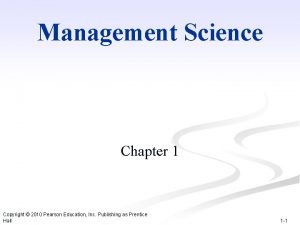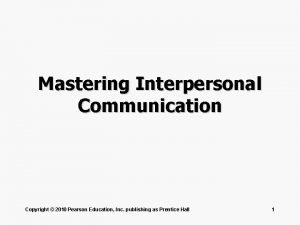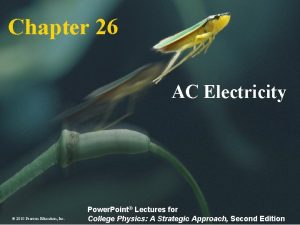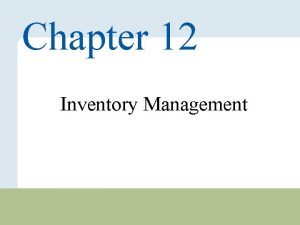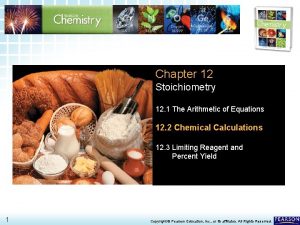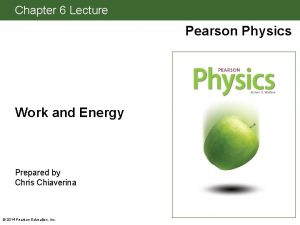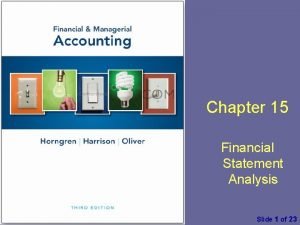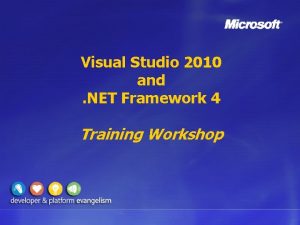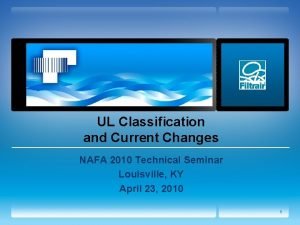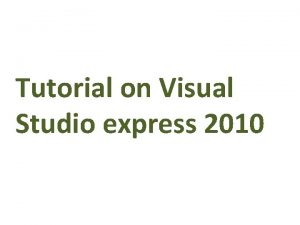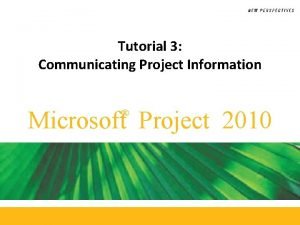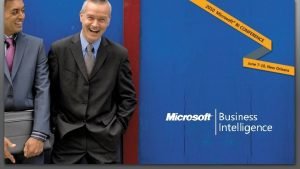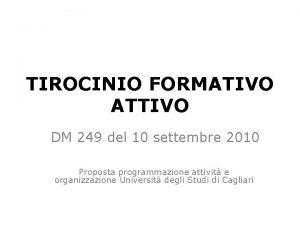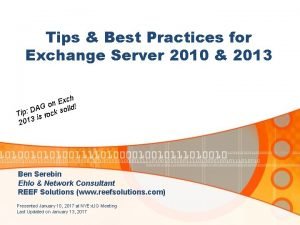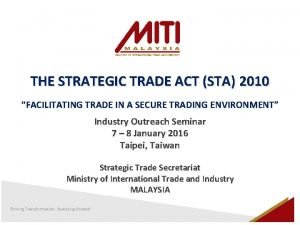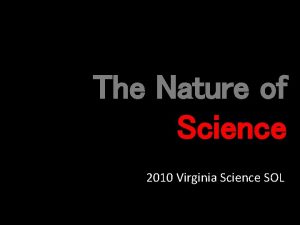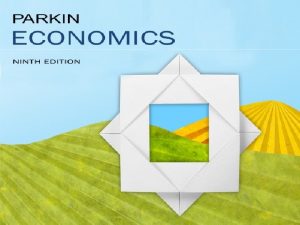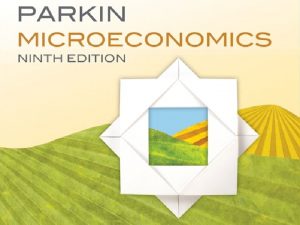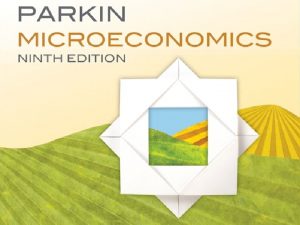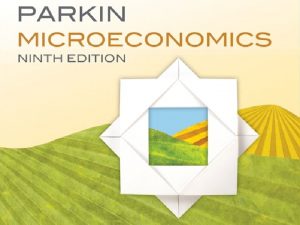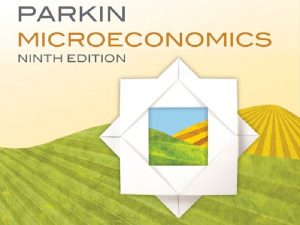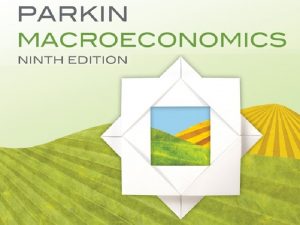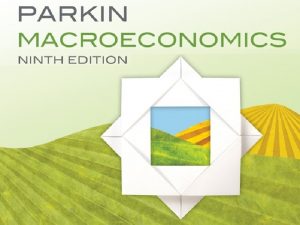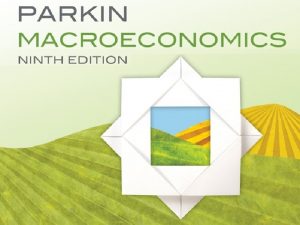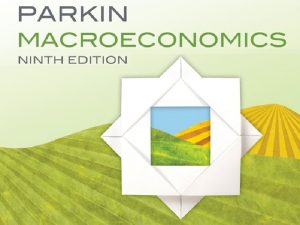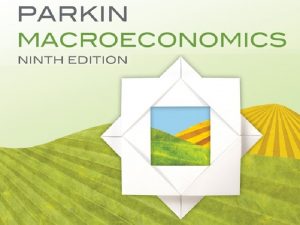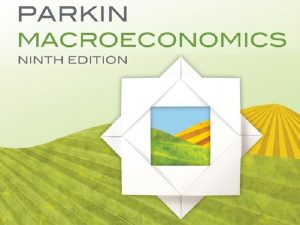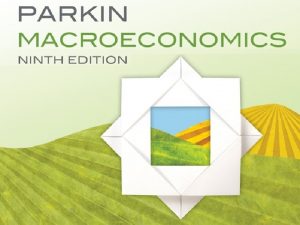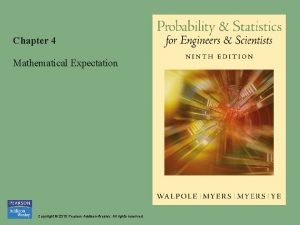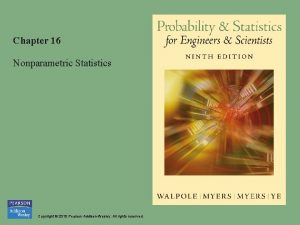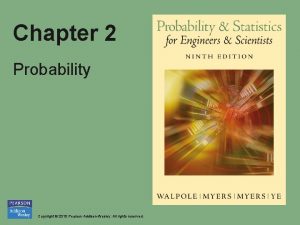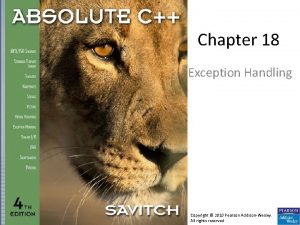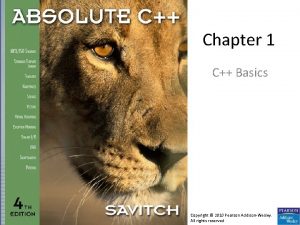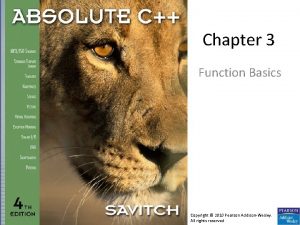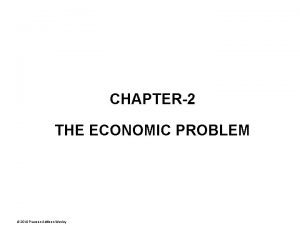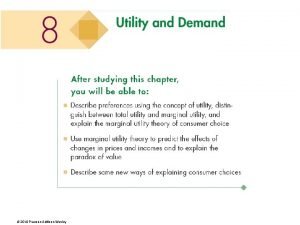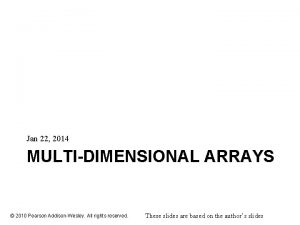CHAPTER 2010 Pearson AddisonWesley 1 2010 Pearson AddisonWesley
























































- Slides: 56

CHAPTER © 2010 Pearson Addison-Wesley 1

© 2010 Pearson Addison-Wesley

Money has taken many forms. What is money today? What happens when the bank lends the money we’re deposited to someone else? How does the Fed influence the quantity of money? What happens when the Fed creates too much money? © 2010 Pearson Addison-Wesley

What is Money? Money is any commodity or token that is generally acceptable as a means of payment. A means of payment is a method of settling a debt. Money has three other functions: < Medium of exchange < Unit of account < Store of value © 2010 Pearson Addison-Wesley

What is Money? Medium of Exchange A medium of exchange is an object that is generally accepted in exchange for goods and services. In the absence of money, people would need to exchange goods and services directly, which is called barter. Barter requires a double coincidence of wants, which is rare, so barter is costly. © 2010 Pearson Addison-Wesley

What is Money? Unit of Account A unit of account is an agreed measure for stating the prices of goods and services. Store of Value As a store of value, money can be held for a time and later exchanged for goods and services. © 2010 Pearson Addison-Wesley

What is Money? Money in the United States Today Money in the United States consists of < Currency < Deposits at banks and other depository institutions The notes and coins held by households and firm is called currency. © 2010 Pearson Addison-Wesley

What is Money? Official Measures of Money The two main official measures of money in the United States are M 1 and M 2. M 1 consists of currency and traveler’s checks and checking deposits owned by individuals and businesses. M 2 consists of M 1 plus time, saving deposits, money market mutual funds, and other deposits. © 2010 Pearson Addison-Wesley

What is Money? The figure illustrates the composition of M 1 and M 2 in June 2008. It also shows the relative magnitudes of the components. © 2010 Pearson Addison-Wesley

What is Money? Are M 1 and M 2 Really Money? All the items in M 1 are means of payment. Some saving deposits in M 2 are not means of payments— they are called liquid assets. Liquidity is the property of being instantly convertible into a means of payment with little loss of value. Deposits are money, but checks are not–a check is an instruction to a bank to transfer money. Credit cards are not money. A credit card enables the holder to obtain a loan, but it must be repaid with money. © 2010 Pearson Addison-Wesley

Depository Institutions A depository institution is a firm that takes deposits from households and firms and makes loans to other households and firms. The institutions in the banking system divide into < Commercial banks < Thrift institutions < Money market mutual funds © 2010 Pearson Addison-Wesley

Depository Institutions Commercial Banks A commercial bank is a private firm that is licensed by the Comptroller of the Currency or by a state agency to receive deposits and make loans. Thrift Institutions Savings and loan associations, savings banks, and credit union are called thrift institutions. Money Market Mutual Funds A money market mutual fund is a fund operated by a financial institution that sells shares in the fund and holds assets such as U. S. Treasury bills. © 2010 Pearson Addison-Wesley

Depository Institutions What Depository Institutions Do To goal of any bank is to maximize the wealth of its owners. To achieve this objective, interest rate at which it lends exceeds the interest rate it pays on deposits. But the banks must balance profit and prudence: < Loans generate profit. < Depositors must be able to obtain their funds when they want them. © 2010 Pearson Addison-Wesley

Depository Institutions A commercial bank puts the depositors’ funds into four types of assets: 1. Reserves—notes and coins in its vault or its deposit at the Federal Reserve 2. Liquid assets—U. S. government Treasury bills and commercial bills 3. Securities—longer–term U. S. government bonds and other bonds such as mortgage-backed securities 4. Loans—commitments of fixed amounts of money for agreed-upon periods of time © 2010 Pearson Addison-Wesley

Depository Institutions Table 25. 2 shows the sources and uses of funds in all U. S. commercial banks in June 2008. © 2010 Pearson Addison-Wesley

Depository Institutions Economic Benefits Provided by Depository Institutions Depository institutions make a profit from the spread between the interest rate they pay on their deposits and the interest rate they charge on their loans. Depository institutions provide four benefits: < Create liquidity < Pool risk < Lower the cost of borrowing < Lower the cost of monitoring borrowers © 2010 Pearson Addison-Wesley

Depository Institutions How Depository Institutions Are Regulated Depository institutions engage in risky business. The make the risk of failure small, depository institutions are required to hold levels of reserves and owners’ capital equal to or surpass ratios laid down by regulation. If a depository institution fails, deposits are guaranteed up to $250, 000 per depositor per bank by FDIC—Federal Deposit Insurance Corporation. © 2010 Pearson Addison-Wesley

Depository Institutions Financial Innovation The aim of financial innovation—the development of new financial products—is to lower the cost of deposits or to increase the return from lending. Two influences on financial innovation are < Economic environment < Technology © 2010 Pearson Addison-Wesley

The Federal Reserve System (the Fed) is the central bank of the United States. A central bank is the public authority that regulates a nation’s depository institutions and control the quantity of money. The Fed’s goals are to keep inflation in check, maintain full employment, moderate the business cycle, and contribute toward achieving long-term growth. In pursuit of its goals, the Fed pays close attention to the federal funds rate—the interest rate that banks charge each other on overnight loans of reserves. © 2010 Pearson Addison-Wesley

The Federal Reserve System The Structure of the Fed The key elements in the structure of the Fed are < The Board of Governors < The regional Federal Reserve banks < The Federal Open Market Committee © 2010 Pearson Addison-Wesley

The Federal Reserve System The Board of Governors Has seven members appointed by the president of the United States and confirmed by the Senate. Board terms are for 14 years and terms are staggered so that one position becomes vacant every 2 years. The president appoints one member to a (renewable) fouryear term as chairman. Each of the 12 Federal Reserve Regional Banks has a nine-person board of directors and a president. © 2010 Pearson Addison-Wesley

The Federal Reserve System The Federal Reserve Banks Figure 25. 1 shows the 12 regions. © 2010 Pearson Addison-Wesley

The Federal Reserve System Federal Open Market Committee The Federal Open Market Committee (FOMC) is the main policy-making group in the Federal Reserve System. It consists of the members of the Board of Governors, the president of the Federal Reserve Bank of New York, and the 11 presidents of other regional Federal Reserve banks of whom, on a rotating basis, 4 are voting members. The FOMC meets every six weeks to formulate monetary policy. © 2010 Pearson Addison-Wesley

The Federal Reserve System The Fed’s Power Center In practice, the chairman of the Board of Governors (since 2006 Ben Bernanke) is the largest influence on the Fed’s policy. He controls the agenda of the Board, has better contact with the Fed’s staff, and is the Fed’s spokesperson and point of contact with the federal government and with foreign central banks and governments. © 2010 Pearson Addison-Wesley

The Federal Reserve System The Fed’s Balance Sheet On the Fed’s balance sheet, the largest and most important asset is U. S. government securities. The most important liabilities are Federal Reserve notes in circulation and banks’ deposits. The sum of Federal Reserve notes, coins, and depository institutions’ deposits at the Fed is the monetary base. © 2010 Pearson Addison-Wesley

The Federal Reserve System Table 25. 3 shows the sources and uses of the monetary base. During the financial crisis in October 2008, the Fed’s loans to depository institutions were larger than in normal times. © 2010 Pearson Addison-Wesley

The Federal Reserve System The Fed’s Policy Tools To achieve its objectives, the Fed uses three main policy tools: < Required reserve ratios < Last resort loans < Open market operations © 2010 Pearson Addison-Wesley

The Federal Reserve System The Fed sets required reserve ratios, which are the minimum percentages of deposits that depository institutions must hold as reserves. The Fed does not change these ratios very often. The Fed is the lender of last resort, which means the Fed stands ready to lend reserves to depository institutions that are short of reserves. An open market operation is the purchase or sale of government securities—U. S. Treasury bills and bonds—by the Federal Reserve System in the open market. © 2010 Pearson Addison-Wesley

How Banks Create Money Creating Deposits by Making Loans Banks create deposits when they make loans and the new deposits created are new money. The quantity of deposits that banks can create is limited by three factors: < The monetary base < Desired reserves < Desired currency holding © 2010 Pearson Addison-Wesley

How Banks Create Money The Monetary Base The monetary base is the sum of Federal Reserve notes, coins, and depository instutitions’ deposits at the Fed. The size of the monetary base limits the total quantity of money that the banking system can create because < Banks have desired reserves < Households and firms have desired currency holdings And both these desired holdings of monetary base depend on the quantity of money. © 2010 Pearson Addison-Wesley

How Banks Create Money Desired Reserves A bank’s actual reserves consists of notes and coins in its vault and its deposit at the Fed. The fraction of a bank’s total deposits held as reserves is the reserve ratio. The desired reserve ratio is the ratio of reserves to deposits that a bank wants to hold. This ratio exceeds the required reserve ratio by the amount that the bank determines to be prudent for its daily business. Excess reserves equal actual reserves minus desired reserves. © 2010 Pearson Addison-Wesley

How Banks Create Money Desired Currency Holding People hold some fraction of their money as currency. So when the total quantity of money increases, so does the quantity of currency that people want to hold. Because desired currency holding increases when deposits increase, currency leaves the banks when they make loans and increase deposits. This leakage of currency is called the currency drain. The ratio of currency to deposits is called the currency drain ratio. © 2010 Pearson Addison-Wesley

How Banks Create Money The Money Creation Process The eight steps in the money creation process are 1. Banks have excess reserves. 2. Banks lend excess reserves. 3. The quantity of money increases. 4. New money is used to make payments. 5. Some of the new money remains on deposit. 6. Some of the new money is a currency drain. 7. Desired reserves increase because deposits have increased. 8. Excess reserves decrease, but remain positive. © 2010 Pearson Addison-Wesley

How Banks Create Money Figure 25. 2 illustrates how the banking system creates money by making loans. © 2010 Pearson Addison-Wesley

How Banks Create Money The Money Multiplier The money multiplier is the ratio of the change in the quantity of money to the change in the monetary base. In our example, when the monetary base increased by $100, 000, the quantity of money increased by $250, 000, so the money multiplier is 2. 5. © 2010 Pearson Addison-Wesley

The Market for Money How much money do people want to hold? The Influences on Money Holding The quantity of money that people plan to hold depends on four main factors: < The price level < The nominal interest rate < Real GDP < Financial innovation © 2010 Pearson Addison-Wesley

The Market for Money The Price Level A rise in the price level increases the quantity of nominal money but doesn’t change the quantity of real money that people plan to hold. Nominal money is the amount of money measured in dollars. Real money equals nominal money ÷ price level. The quantity of nominal money demanded is proportional to the price level—a 10 percent rise in the price level increases the quantity of nominal money demanded by 10 percent. © 2010 Pearson Addison-Wesley

The Market for Money The Nominal Interest Rate The nominal interest rate is the opportunity cost of holding wealth in the form of money rather than an interest-bearing asset. A rise in the nominal interest rate on other assets decreases the quantity of real money that people plan to hold. Real GDP An increase in real GDP increases the volume of expenditure, which increases the quantity of real money that people plan to hold. © 2010 Pearson Addison-Wesley

The Market for Money Financial Innovation Financial innovation that lowers the cost of switching between money and interest-bearing assets decreases the quantity of real money that people plan to hold. The Demand for Money The demand for money is the relationship between the quantity of real money demanded and the nominal interest rate when all other influences on the amount of money that people wish to hold remain the same. © 2010 Pearson Addison-Wesley

The Market for Money Figure 25. 3 illustrates the demand for money curve. A rise in the interest rate brings a decrease in the quantity of real money demanded. A fall in the interest rate brings an increase in the quantity of real money demanded. © 2010 Pearson Addison-Wesley

The Market for Money Shifts in the Demand for Money Curve Figure 25. 4 shows that a decrease in real GDP or a financial innovation decreases the demand for money and shifts the demand curve leftward. An increase in real GDP increases the demand for money and shifts the demand curve rightward. © 2010 Pearson Addison-Wesley

The Market for Money Market Equilibrium Money market equilibrium occurs when the quantity of money demanded equals the quantity of money supplied. Adjustments that occur to bring about money market equilibrium are fundamentally different in the short run and the long run. © 2010 Pearson Addison-Wesley

The Market for Money Short-Run Equilibrium Figure 25. 5 shows the demand for money. Suppose that the Fed’s interest rate target is 5 percent a year. The Fed adjusts the quantity of money each day to hit its interest rate target. © 2010 Pearson Addison-Wesley

The Market for Money If the interest rate exceeds the target interest rate, the quantity of money that people are willing to hold is less than the quantity supplied. They try to get rid of their “excess” money they are holding by buying bonds. This action lowers the interest rate. © 2010 Pearson Addison-Wesley

The Market for Money If the interest rate is below the target interest rate, the quantity of money that people want to hold exceeds the quantity supplied. They try to get more money by selling bonds. This action raises the interest rate. © 2010 Pearson Addison-Wesley

The Market for Money Long-Run Equilibrium In the long run, the loanable funds market determines the real interest rate. Nominal interest rate equals the equilibrium real interest rate plus the expected inflation rate. Real GDP equals potential GDP, so the only variable left to adjust in the long run is the price level. © 2010 Pearson Addison-Wesley

The Market for Money The price level adjusts to make the quantity of real money supplied equal to the quantity demanded. When the Fed changes the nominal quantity of money, the price level changes in the long run by the same percentage as the percentage change in the quantity of nominal money. In the long run, the change in the price level is proportional to the change in the quantity of nominal money. © 2010 Pearson Addison-Wesley

The Quantity Theory of Money The quantity theory of money is the proposition that, in the long run, an increase in the quantity of money brings an equal percentage increase in the price level. The quantity theory of money is based on the velocity of circulation and the equation of exchange. The velocity of circulation is the average number of times in a year a dollar is used to purchase goods and services in GDP. © 2010 Pearson Addison-Wesley

The Quantity Theory of Money Calling the velocity of circulation V, the price level P, real GDP Y, and the quantity of money M: V = PY ÷ M. The equation of exchange states that MV = PY. The equation of exchange becomes the quantity theory of money if M does not influence V or Y. So in the long run, the change in P is proportional to the change in M. © 2010 Pearson Addison-Wesley

The Quantity Theory of Money Expressing the equation of exchange in growth rates: Money growth rate + Rate of velocity change = Inflation rate + Real GDP growth Rearranging: Inflation rate = Money growth rate + Rate of velocity change Real GDP growth In the long run, velocity does not change, so Inflation rate = Money growth rate Real GDP growth © 2010 Pearson Addison-Wesley

Mathematical Note: The Money Multiplier To see how the process of money creation works, suppose that the desired reserve ratio is 10 percent and the currency drain ratio is 50 percent. The process starts when all banks have zero excess reserves and the Fed increases the monetary base by $100, 000. The figure in the next slide illustrates the process and keeps track of the numbers. © 2010 Pearson Addison-Wesley

Mathematical Note: The Money Multiplier The bank with excess reserves of $100, 000 loans them. Of the amount loaned, $33, 333 (50 percent) drains from the bank as currency and $66, 667 remains on deposit. © 2010 Pearson Addison-Wesley

Mathematical Note: The Money Multiplier The bank’s reserves and deposits have increased by $66, 667, so the bank keeps $6, 667 (10 percent) as reserves and loans out $60, 000. © 2010 Pearson Addison-Wesley

Mathematical Note: The Money Multiplier $20, 000 (50 percent of the loan) drains off as currency and $40, 000 remain on deposit. © 2010 Pearson Addison-Wesley

Mathematical Note: The Money Multiplier The process repeats until the banks have created enough deposits to eliminate the excess reserves. $100, 000 of excess reserves creates $250, 000 of money. © 2010 Pearson Addison-Wesley

Mathematical Note: The Money Multiplier The size of the money multiplier depends on < The currency drain ratio (a) < The desired reserve ratio (b) Money multiplier = (1 + a)/(a + b) In our example, a is 0. 5 and b is 0. 1, so Money multiplier = (1 + 0. 5)/(0. 1 + 0. 5) = (1. 5)/(0. 6) = 2. 5 © 2010 Pearson Addison-Wesley
 2010 pearson education inc
2010 pearson education inc Copyright 2010 pearson education inc
Copyright 2010 pearson education inc 2010 pearson education inc answers
2010 pearson education inc answers 2010 pearson education inc answers
2010 pearson education inc answers 2010 pearson education inc answers
2010 pearson education inc answers 2010 pearson education inc answers
2010 pearson education inc answers 2010 pearson education inc
2010 pearson education inc 2010 pearson education inc
2010 pearson education inc Copyright 2010 pearson education inc
Copyright 2010 pearson education inc 2010 pearson education inc
2010 pearson education inc Copyright 2010 pearson education inc
Copyright 2010 pearson education inc The four forces shown have the same strength
The four forces shown have the same strength Decimal in words example
Decimal in words example 2010 pearson education inc
2010 pearson education inc Pearson education 2010
Pearson education 2010 2010 pearson education inc
2010 pearson education inc Pearson 2010
Pearson 2010 2010 pearson education inc answers
2010 pearson education inc answers 2010 pearson education inc
2010 pearson education inc 2010 pearson education inc
2010 pearson education inc 2010 pearson education inc answers
2010 pearson education inc answers 2010 pearson education inc
2010 pearson education inc 2010 pearson education inc
2010 pearson education inc Copyright 2010 pearson education inc
Copyright 2010 pearson education inc Copyright 2010 pearson education inc
Copyright 2010 pearson education inc Copyright 2010 pearson education inc
Copyright 2010 pearson education inc Copyright 2010 pearson education inc
Copyright 2010 pearson education inc Copyright 2010 pearson education inc
Copyright 2010 pearson education inc Composition copyright example
Composition copyright example Copyright 2010 pearson education inc
Copyright 2010 pearson education inc Pearson education inc. all rights reserved
Pearson education inc. all rights reserved 2010 pearson education inc answers
2010 pearson education inc answers Balance sheet pearson
Balance sheet pearson Reorder point formula example
Reorder point formula example 2010 pearson education inc
2010 pearson education inc 2011 pearson education
2011 pearson education Pearson education inc publishing as pearson prentice hall
Pearson education inc publishing as pearson prentice hall Pearson vue ceo
Pearson vue ceo Stress management for life 5th edition
Stress management for life 5th edition Pearson education inc publishing as pearson prentice hall
Pearson education inc publishing as pearson prentice hall Pearson 2012
Pearson 2012 2008 pearson prentice hall inc
2008 pearson prentice hall inc Chapter 12 stoichiometry answer key pearson
Chapter 12 stoichiometry answer key pearson Pearson chapter 6
Pearson chapter 6 Fiancial analysis chapter 15 pearson solutions
Fiancial analysis chapter 15 pearson solutions Return on common stockholders equity
Return on common stockholders equity Microsoft windows small business server 2011 essentials
Microsoft windows small business server 2011 essentials Visual studio 2010 training
Visual studio 2010 training Ul 2010
Ul 2010 Visual studio 2010 c express
Visual studio 2010 c express Microsoft project 2010 tutorial
Microsoft project 2010 tutorial Microsoft office project tutorial
Microsoft office project tutorial Visio 2010 updates
Visio 2010 updates Dm 249 del 2010
Dm 249 del 2010 Start-dagmaintenancemode
Start-dagmaintenancemode Bell trade act
Bell trade act Earth science sol 2010
Earth science sol 2010


